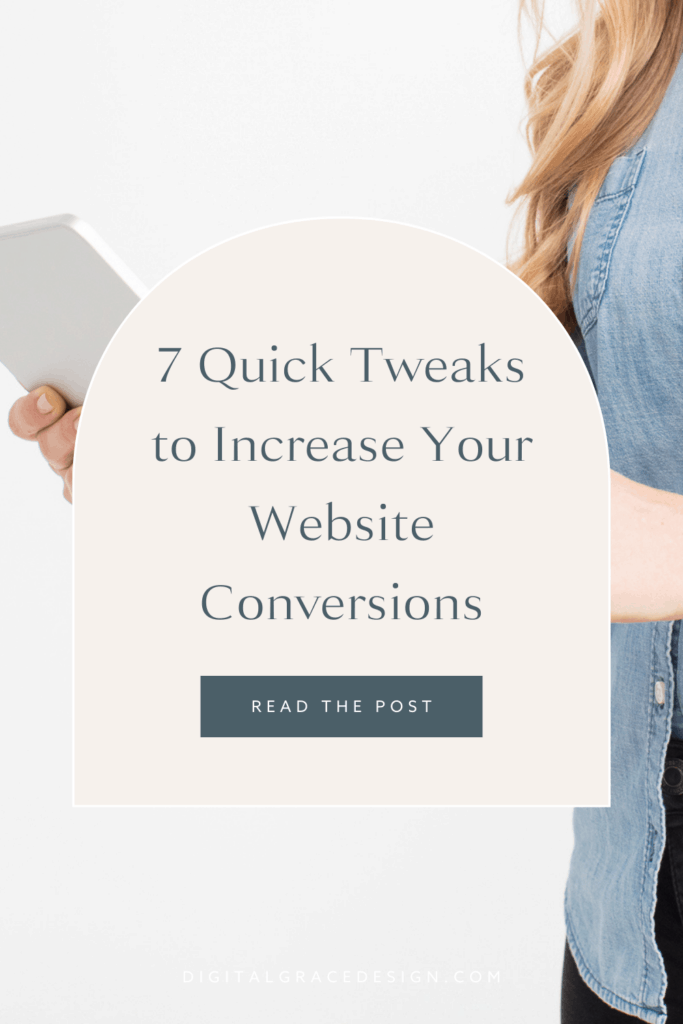When someone lands on your website, how likely are they to take action? This question is at the heart of creating a website your audience loves to interact with.
By calculating your website conversion rate, you’ll be able to see how many visitors are persuaded to take action on your site. This could look like contacting you, scheduling a consultation call, buying your product, or signing up for your email list.
The action you want them to take usually depends on what page they land on your website. Since each page has a different set of goals, it’s important to make sure you’re optimizing each page for better conversions.
In this article, I’ll share my best tips for improving your website conversions and pair them with strategic tweaks you can make to your website as soon as today.
7 ways to improve your website conversion rates
The higher your website conversion rate, the more your brand is resonating with your visitors and creating more sales. To attract potential customers and turn their initial interest into sales, you’ll need to create a strategic website.
Here are a few ways to ensure you’re making the most of your visitor’s time on your website.
Include one call-to-action
Imagine the last time you walked into a store. If you’re an avid online shopper, you may have to go back into your memories for this. Let’s say you were browsing the aisles, letting yourself aimlessly wander the store.
However, when you finally found a product you could like, you were met by dozens of options. Do you make a decision based on brand, pricing, convenience, or something else entirely? How could you know which product to choose when they all seemed so unfamiliar?
Most people who experience this kind of confusion stop what they’re doing and walk away. This is what psychologists call analysis paralysis (or decision paralysis), and it’s all too common.
While we may think that giving plenty of options will increase the opportunities of someone finding what they like, we actually end up creating an overwhelming situation. Causing visitors to overthink their purchasing decisions is one of the quickest ways to reduce your website conversions.
This is why marketers recommend that you choose one call-to-action (CTA) for each website page. With the exception of your homepage, having one CTA per page will allow you to focus your energy on inspiring your audience to take a specific action.
You’ll notice on my own website, my main CTA is to persuade others to start their project. This leads them to my Contact page where they can fill out a project inquiry form.
You’ll see the “Start Your Project” CTA in my top website navigation…

…and sprinkled throughout my Service page.
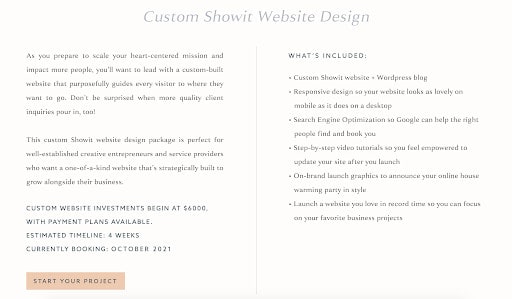
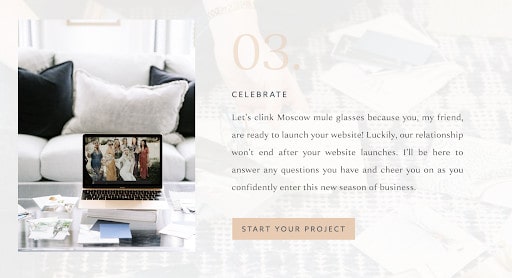
I love keeping my CTA consistent so whenever my visitors are ready to take action, they know exactly where to go and how to get in touch with me. This strategy has worked well for me, along with countless other business owners, so I recommend doing the same with your website.
Strengthen your button copy
By now, you’ve likely started to think about which CTAs you want to use. This is a great first step, but the work doesn’t stop there. Next, you’ll need to write copy for each button.
Your button copy should tell your audience what happens when it’s clicked. Otherwise, visitors may be confused as to what action they should take. This means your button copy should be descriptive but still concise.
When it comes to button copy, Maria from Bloom & Grow Radio’s website really stands out.
Some of my favorites from her are:
- Snag the guide (for downloadable freebies)
- Subscribe now (for the podcast)
- Join the club (for downloadable art prints)
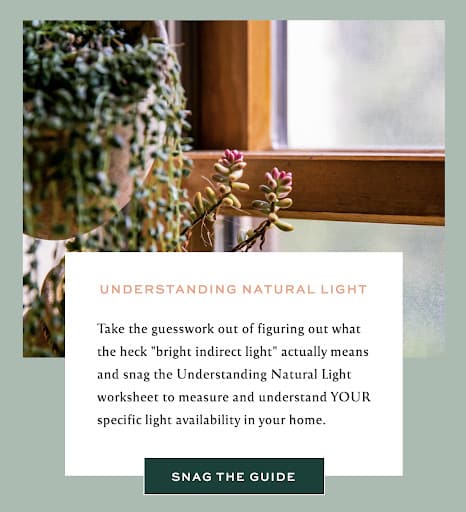
If you’re looking for more inspiration, check out my article on How to Choose the Right CTAs for Your Website. You’ll find 10 CTA button copy examples along with tips on how to write your own button copy.
As long as you’re using action-oriented words, you’ll be golden!
Reduce form fields
If one of your main CTAs is to motivate people to contact you or schedule a discovery call, you’ll probably be sending people to a Contact page. On this page, you may have a contact form with form fields for someone to fill out before they send you their message.
While it may be tempting to get as much information as you can, reducing the number of form fields on your Contact page will increase your website conversions.
A standard contact form comes with three main form fields: Name, Email Address, and Message. Hubspot found that keeping your contact form to three fields can increase conversions by up to 50%.
Sonia of Glossible kept her contact form simple with the same three form fields. This makes it easier for people to contact her about their specific questions or requests.
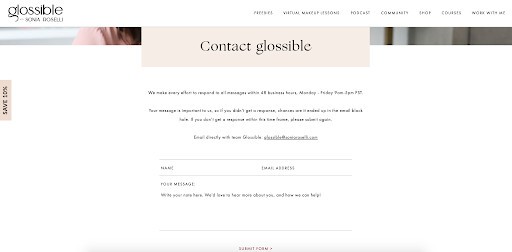
She also added more information about when you can expect to hear from her, her studio hours, and how to contact her directly. This is a good idea for all entrepreneurs!
You can certainly add more form fields to your Contact page if you need more information (or find that you’re getting many leads and need to qualify them more before initial contact), but try to keep it as simple as possible. I usually recommend completing your contact form and then taking one more form field away, just for good measure.
Optimize for search engines
If optimizing your website for search engines has fallen to the bottom of your to-do list, it might be time to revisit it. It’s difficult to increase your website conversions if you aren’t driving traffic to your site. Without traffic, people won’t land on your website in the first place.
I love teaching my clients and other entrepreneurs about SEO through my Simple Showit SEO course because I’ve seen how influential it can be in driving more leads and increasing website conversions.
While search engine optimization strategies require you to play the long game, there are quick tweaks you can make to set yourself up for success.
Here are a few of my favorites:
- Choose the right keywords based on your business niche
- Add alt text to your imagery for better accessibility
- Write unique page titles and meta descriptions for your website pages
That’s just a start, but it will help you build a stronger SEO foundation for the future of your brand. When you’re ready to dive in deeper, my Simple Showit SEO course can help!
Since keywords are an important part of optimizing your website for SEO, it’s good to sprinkle them throughout your website page to increase your chances of ranking.
For example, look at Moxie Bright Events’ website. When we collaborated on her website copywriting, we knew it would be important to mention that she was based in Los Angeles. This is because brides are frequently searching for wedding vendors in their local area.
You’ll notice her subheadline on the homepage says “Los Angeles-Based Wedding Planning” because that is one of her most important keywords.

We also mention that she’s based in Los Angeles in her website footer. This keeps her location consistent on every page of her website which is a smart SEO move.

Location-based SEO isn’t the only way to get ahead, but it can be helpful for those who serve clients in their local area. If you serve clients nationwide or globally, you can still use niche-specific keywords to target your audience. It just takes some practice and a whole lot of time and dedication to see results!
Improve your site speed
Did you know 47% of consumers expect a website to load in less than two seconds? That’s almost in the blink of an eye! As of 2013, we now have a shorter attention span than goldfish.
This is precisely why checking your page load speed is important. You could write incredible copy that’s ready to sell your product or service, but if people navigate away from your website because of its low speed, it won’t do your business any good.
I usually recommend using PageSpeed Insights, a Google product that allows you to input your URL and test your page speed. It will give you a score from one to 100 along with a list of things you can do to improve your loading speeds.

You can make these changes yourself or work with a website developer to resolve any issues you may be experiencing. This is one of the quickest ways to increase the likelihood that someone will stay on your website once they’ve landed there.
Change your headlines
One of the best things you can do to increase website conversions is to test your headlines. Your headline copy is often the first thing a visitor will read when they land on your website page. It must pack a punch in order for you to convince visitors to take action.
When you write a headline, you must make sure it is:
- Concise
- Relevant
- Easy to understand
- Niched down
- Audience-specific
- Actionable
One of my favorite headline and subheadline pairings comes from Carolyn Teague. I love the optimism and expansiveness of a headline like “Embrace New Possibilities in Health.” However, she needed a subheadline to share exactly how she can help, which is through “Functional Medicine Virtual Consults.”
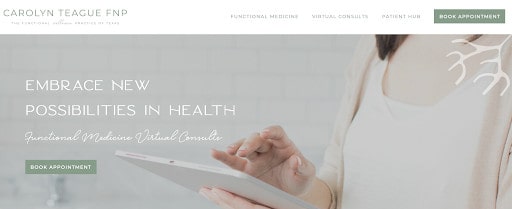
However, before you commit to a specific headline, you may want to test different variations. This is often called a split test, which allows you to compare one headline against another. The results will show you which headline (or any other element you want to test) gives you the best conversion rates.
These insights are so valuable, but you need to be willing to experiment if you want to improve your headlines. To get started, I usually recommend writing five to 10 headline variations so you have a bank to choose from.
Then, once you’ve chosen at least two headlines you want to test, you can use a split-testing tool to start your experiment. If you’ve never used this kind of software before, I recommend checking out these split testing tools.
Once you test your headlines, you can test other elements on your website like your:
- CTA button copy
- CTA button color/contrast
- CTA button placement
- Description copy
- Page content length
The sky’s the limit here! This is more of an advanced strategy for those who really want to perfect their website for conversions, but with the right tool, improving conversions can be simple.
Add live chat features
If you really want to go above and beyond, you can capture your audience’s attention by adding a live chat feature to your site. You’ve probably seen these chat boxes on websites before, but did you know how effective they are?
Studies have shown that 75% of customers prefer to text or chat with businesses instead of talking with a representative. This is a big reason why 80% of businesses are hoping to integrate chat marketing into their website strategy in the next year.
Chat marketing is unique in that you can automate certain messages using tools that are built for communicating with customers at any time of the day. You don’t have to sit around, waiting to answer someone’s question. However, you could offer live support through a chat functionality if you were interested in doing so.
Chat marketing has worked well for Henry of Aevitas Weddings, a client of mine who has pioneered the use of chat marketing in the wedding industry. He even spoke about it at Showit United when I gave a presentation on SEO strategies.
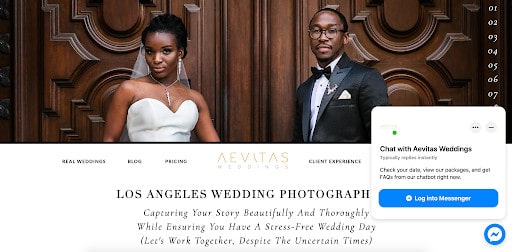
While Henry uses the ManyChat plugin for his own website, you can use other chat marketing tools, depending on your goals and budget.
If you’re wondering if chat marketing works, Henry was kind enough to share his results.
Through this chat marketing case study, Henry shared that he’s used Messenger chats to generate over $60,000 in revenue during the COVID pandemic. This is in addition to the 1,100 new leads he’s been able to attract through this functionality.
Chat marketing is meant to help you capture a lead’s immediate attention when they land on your site. Since website conversions often improve when you are able to generate more quality leads, this may be a strategy to look into.
How will you increase your website conversions over time?
There are many other tweaks you can make to your website, but these seven strategies are an easy way to get started. All of them are quick to implement and easy to track so you know how well your website is performing.
To recap, here are the seven tweaks we just discussed:
- Include one call-to-action
- Strengthen your button copy
- Reduce form fields
- Optimize for search engines
- Improve your site speed
- Change your headlines
- Add live chat features
I challenge you to implement at least ONE of these strategies in the next week and keep an eye on your website analytics.
You’re well on your way to creating a conversion-ready website!
